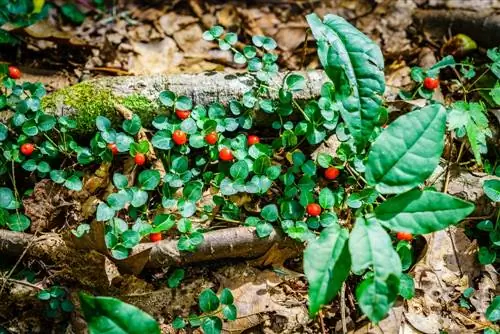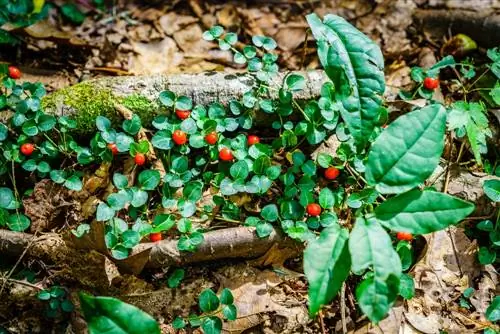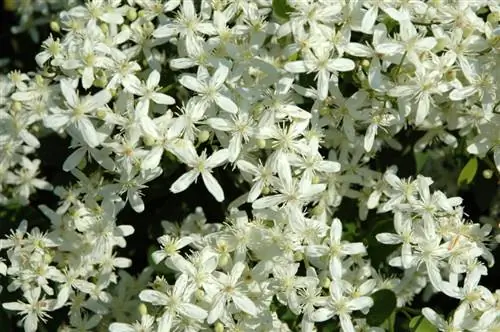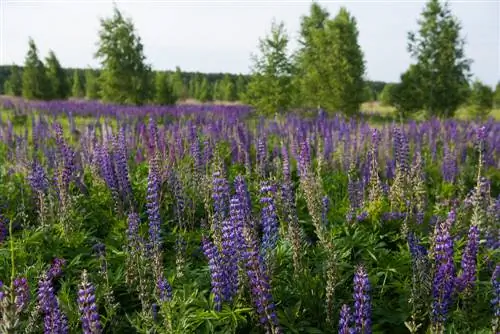- Author admin [email protected].
- Public 2023-12-16 16:46.
- Last modified 2025-01-23 11:22.
Read the commented partridgeberry profile here for useful information about growth, leaves, flowers and fruit. Practically tested tips on the correct planting and care of Mitchella repens as a ground cover.

What is the partridgeberry and how to plant it?
The partridgeberry (Mitchella repens) is an evergreen, ground-cover shrub native to North America. It prefers partially shaded to shady locations and fresh, well-drained soil. The plant is characterized by its white, funnel-shaped flowers, edible dark red berries and hardy properties. It is suitable as a ground cover, underplanting, bird feeder or balcony decoration.
Profile
- Scientific name: Mitchella repens
- Family: Rubiaceae (Rubiaceae)
- Synonym: Partridgeberry
- Origin: North America
- Growth type: herbaceous, woody shrub
- Growth height: 5 cm to 10 cm
- Leaf: roundish-oval
- Flower: funnel-shaped
- Fruit: Berry
- Toxicity: non-toxic
- Winter hardiness: hardy
- Use: ground cover, bird feeder, ornamental plant
Growth
The partridgeberry is a prostrate, herbaceous to woody shrub from North America. Botanically, the distinctive flowering plant belongs to the genus Mitchella within the ruby family (Rubiaceae). The colorful berries are at the top of the menu for partridge, pheasant, turkey and other chicken birds. Since it made the jump across the Atlantic, the partridge berry has enjoyed growing popularity in this country as a beautiful ornamental plant all year round. Read these interesting characteristics of growth:
- Growth habit: evergreen, herbaceous tree with woody, creeping stems; white flowers in spring and dark red berries in autumn.
- Growth height: 5 cm to 10 cm.
- Growth width: 20 cm to 50 cm.
- Roots: Shallow roots with rooted runners.
- Growth speed: 5 cm to 6 cm annual growth.
- Gardenically interesting properties: easy to care for, hardy, shade-tolerant, ground-covering, cut-resistant, non-toxic, slow-growing, ecologically valuable, edible.
Video: Admire real partridge berries up close
Leaf
The creeping shoots of a partridge berry bear attractive leaves all year round with these characteristics:
- Leaf shape: short-stemmed, rounded to oval, rarely heart-shaped.
- Leaf size: 1.5 cm to 2.5 cm long.
- Leaf color: evergreen, dark green-glossy with light yellow central vein.
- Arrangement: opposite
Bloom
In spring, the partridge berry adorns itself with these graceful flowers that exude an intense scent:
- Flower shape: fourfold, funnel-shaped to cup-shaped, petals thinly hairy
- Flower color: white
- Flowering time: May to June
- Flower size: 1 cm in diameter
Interesting detail: Partridgeberry flowers always sit in pairs in the leaf axils and harmoniously share a sepal. As a result, the twin flowers have a common ovule. In order for a single berry to be produced at this point, both flowers must be pollinated. The dark red fruit has two star-shaped dimples that give an idea of the fruitful interaction of the twin flowers.
Fruit
The pollinated flowers of a partridge berry develop into fruits with these properties:
- Fruit type: dark red, spherical drupe with up to 8 seeds
- Fruit size: 0.5 cm to 1 cm in diameter
- Fruit properties: edible
- Taste: bland to tasteless
- Fruit ripeness: July to October
Usage
The partridge berry is evolving from an insider tip among connoisseurs to a popular design component for the creative hobby garden. The reason for the steep career are these inspiring uses:
| Partridgeberry Uses | Tips, tricks, ideas |
|---|---|
| Groundcover | decorative all year round under deciduous and coniferous trees |
| Underplanting | conceals bare base of rhododendron, mountain laurel, azalea |
| Bird food plant | ecologically valuable green areas |
| Shade lawn replacement | conditionally sturdy ground cover in the front garden without lawn |
| Balcony | evergreen hanging plant for hanging baskets and flower boxes |
| Consumption | mild jam, acid-free smoothie, sweet fruit |
| Decoration | tasteful Advent and Christmas decorations |
| Medicinal plant | healing tea relieves |
| + Rheumatism | |
| + Arthritis | |
| + Urinary tract infection |
Planting partridgeberries
A ready-to-plant partridge berry can be bought in tree nurseries and perennial nurseries for a price starting at 4.90 euros. Thrifty hunters plant the tree after propagation through cuttings. The best time to plant is in autumn. Where and how to plant Mitchella repens correctly, read here:
Propagation
It's so easy to propagate the partridge berry through cuttings:
- Cut half-woody, non-flowering shoot tips as cuttings in spring.
- Leave the lower half of every 5 cm to 8 cm small cutting.
- Let the cuttings root either in a partially shaded propagation bed or in a pot.
In contrast, sowing is a time-consuming undertaking. As cold germinators, the seeds must be subjected to stratification. As part of the process, the seeds first go through a four-week, warm, moist phase at 18° to 22° Celsius. This is followed by a six-week cold stimulus at -4° to +4° Celsius. Until germination, the seeds remain at temperatures of 5° to 12° Celsius, which gradually rise to 18° to 22° Celsius.
Location, soil, substrate
The location requirements of a partridgeberry are modest:
- Sunny, semi-shady to shady location.
- Fresh garden soil, well-drained, loose humus, neutral to slightly acidic.
- Exclusion criteria: full sun, waterlogging, alkaline pH greater than 7.5, compacted clay soil.
A mix of peat-free rhododendron soil, coconut humus as a peat substitute and lava granules is suitable as a substrate for a partridge berry in a pot.
Planting Tips
You can read the best tips for planting Mitchella repens here:
- Preparation: Place the root ball in rainwater until no more air bubbles appear.
- Dimensions of a planting pit: 20 cm x 20 cm x 20 cm; at least twice the volume of the root ball.
- Improve excavation: mix half with rhododendron soil and sifted compost.
- Planting requirements as ground cover: 12 to 16 pieces per m²
- Partridgeberry in a pot: recommended substrate to be filled over expanded clay drainage.
Please note: In the year of planting, a delicate young plant does not yet have the tough winter hardiness of adult partridge berries. An airy, loose cover made of spruce branches protects the tree from frost damage in the first winter.
Excursus
Danger of confusion with poisonous false berries
Partridge berry (Mitchella repens) and red berry (Gaultheria procumbens) look very similar. The red carpet berry or red false berry is a ground-covering, evergreen shrub from the genus false berries (Gaultheria) within the heather family (Ericaceae). In contrast to the edible partridge berry, a red pseudoberry fruits with poisonous, spherical, red capsules that even birds avoid. Unfortunately, the trade sometimes offers both plant species as red partridge berries. A look at the botanical name ensures clarity when purchasing.
Care for partridgeberry
The partridgeberry is very easy to care for. However, you should not leave a Mitchella repens completely to its own devices. These care tips get to the heart of all gardening care:
- Watering: If the soil is dry, water with rainwater.
- Fertilizing: Add liquid fertilizer to the irrigation water every two to three weeks from April to September.
- Pruning: Only prune partridgeberries if necessary between October and February.
- Overwintering: water in case of frost on mild days, protect from winter sun, cover the planter with fleece and place it on wood.
A blanket of fallen leaves deprives the evergreen ground cover of air to breathe and triggers rot. The most important care measure in autumn is the regular sweeping of autumn leaves.
Popular varieties
No varieties are known beyond the partridge berry as the original species.
FAQ
Are the fruits of a partridge berry edible?
Indeed, the fruits of a partridgeberry (Mitchella repens) are suitable for consumption. Because the pulp lacks any acid, the dark red berries are bland or tasteless. The natives of North America valued the fruits as a welcome dietary supplement and healing tea in winter. In Newfoundland, partridge berries are still used as an ingredient in a traditional jam.
Is the partridgeberry hardy?
The partridge berry (Mitchella repenes) is completely hardy down to -35° Celsius. For this reason, the North American tree is mentioned in the same breath as native plants for extreme cold, such as alpine currant (Ribes alpinum) or cranberry (Vaccinium vitis-idaea).
Is the partridge berry suitable as a sturdy lawn replacement?
The partridge berry (Mitchella repens) can cope with occasional walking without any injuries. The wood is quite suitable as a replacement for a sporadically used shade lawn. For a green area in the family garden, reliable ground cover is recommended, such as Roman chamomile (Anthemis nobilis v. ligulosa) or star moss (Sagina subulata).
Will the flowering period be canceled if I cut the partridgeberry in March?
Pruning in spring can significantly limit the flowering of a partridgeberry (Mitchella repens). The best time to prune is in autumn, in time before the buds form for the next flowering period. Nature-oriented hobby gardeners wait until hungry garden birds have eaten most of the berries and cut the ground cover on a frost-free winter day.






